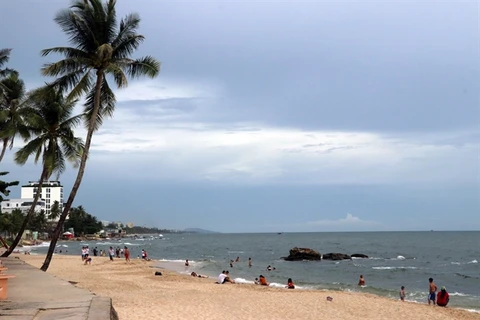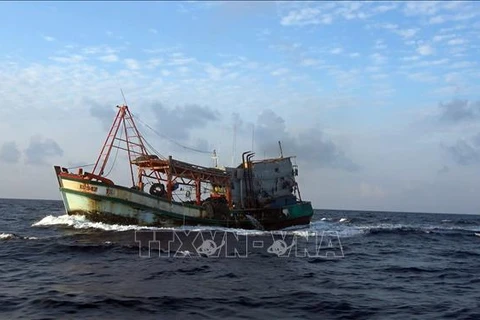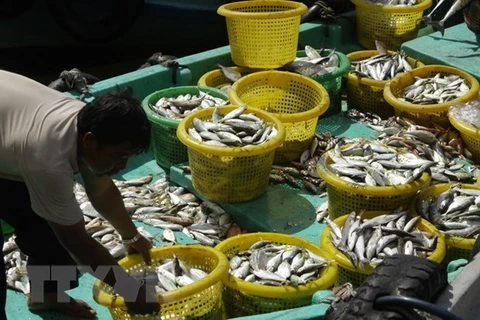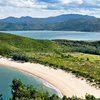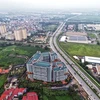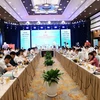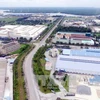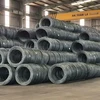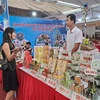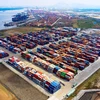Kien Giang (VNS/VNA) – The Mekong Delta province of Kien Giang hopes to harvest at least 86,000 tonnes of aquatic products from aquaculture from now through year end to take the output for the year to 315,000 tonnes.
If achieved, the figure will be in excess of the province’s target for the year, according to the provincial Department of Agriculture and Rural Development.
The province is increasing the breeding of bivalve molluscs in mudflats, and shrimp, fish, mud crab and other high-value species in coastal areas, mangrove forests and the sea.
The province Fisheries Sub-department, in-cooperation with localities in flood-prone areas, the Long Xuyen Quadrangle and the western bank of the Hau River, has instructed farmers to take advantage of the ongoing flood season to breed freshwater fish and other aquatic species in rice fields, rivers and canals.
The province aims to harvest 6,700 tonnes of brackish water shrimp during the rest of the year to meet its full-year target of 108,500 tonnes.
For this, the province has encouraged farmers to expand industrial and semi-industrial shrimp farming models, especially two-stage industrial farming.
Under the two-stage model, multiple ponds are used for breeding shrimp and treating water. Shrimp fry is first bred in a nursery for a few weeks before being transferred to the main ponds for intensive farming.
The main ponds have oxygenation equipment, anti-sunlight nets and plastic sheets covering their beds.
Farmers can get yields of 60 tonnes per hectare per crop under the model and breed three to four crops a year. It is also environment-friendly.
The province’s Agriculture Extension Centre has stepped up training for farmers in the techniques used under the model in recent years.
Trinh Quanh Hoc of Hon Dat district’s Tho Son commune earns a high income from breeding shrimp under the model.
He has two 300 sq.m nursery ponds and three 1,200 sq.m ponds for intensive breeding, and earned more than 880 million VND (36,200 USD) per crop last year after the Agriculture Extension Centre helped him to implement the model.
The model involves high initial investment, but makes it easy to manage diseases, food residues, water, and the environment, he said.
“Its yield and efficiency are higher than other industrial shrimp farming models.”
Kien Giang, the country’s largest rice producer, has also expanded the shrimp-rice farming model since it makes clean products that meet market requirements.
Under the model, farmers cultivate rice in the rainy season and breed shrimp in the dry season in the same field.
This year the Fisheries Sub-department has instructed farmers to strictly follow forecasts on weather, rains, storms, environment, and water resources so that they can cope with possible disease outbreaks.
The province is this year farming aquatic species on more than 293,160ha, including 142,425ha of brackish water shrimp, according to the department.
It also has 3,696 floating cages in the sea for aquaculture. It has harvested more than 229,150 tonnes from aquaculture this year, up 9.8% year-on-year.
Authorities have tightened oversight of the quality of broodstock, especially shrimp, to prevent diseases, and encourage farmers to buy those with origin traceability and inform them about diseases for prompt treatment.
The province has had few disease outbreaks in major shrimp breeding areas this year because of good management and favourable weather, according to the department.
Farmers have earned high incomes from aquaculture this year because of the high prices they get since seafood exports have increased, it said./.
If achieved, the figure will be in excess of the province’s target for the year, according to the provincial Department of Agriculture and Rural Development.
The province is increasing the breeding of bivalve molluscs in mudflats, and shrimp, fish, mud crab and other high-value species in coastal areas, mangrove forests and the sea.
The province Fisheries Sub-department, in-cooperation with localities in flood-prone areas, the Long Xuyen Quadrangle and the western bank of the Hau River, has instructed farmers to take advantage of the ongoing flood season to breed freshwater fish and other aquatic species in rice fields, rivers and canals.
The province aims to harvest 6,700 tonnes of brackish water shrimp during the rest of the year to meet its full-year target of 108,500 tonnes.
For this, the province has encouraged farmers to expand industrial and semi-industrial shrimp farming models, especially two-stage industrial farming.
Under the two-stage model, multiple ponds are used for breeding shrimp and treating water. Shrimp fry is first bred in a nursery for a few weeks before being transferred to the main ponds for intensive farming.
The main ponds have oxygenation equipment, anti-sunlight nets and plastic sheets covering their beds.
Farmers can get yields of 60 tonnes per hectare per crop under the model and breed three to four crops a year. It is also environment-friendly.
The province’s Agriculture Extension Centre has stepped up training for farmers in the techniques used under the model in recent years.
Trinh Quanh Hoc of Hon Dat district’s Tho Son commune earns a high income from breeding shrimp under the model.
He has two 300 sq.m nursery ponds and three 1,200 sq.m ponds for intensive breeding, and earned more than 880 million VND (36,200 USD) per crop last year after the Agriculture Extension Centre helped him to implement the model.
The model involves high initial investment, but makes it easy to manage diseases, food residues, water, and the environment, he said.
“Its yield and efficiency are higher than other industrial shrimp farming models.”
Kien Giang, the country’s largest rice producer, has also expanded the shrimp-rice farming model since it makes clean products that meet market requirements.
Under the model, farmers cultivate rice in the rainy season and breed shrimp in the dry season in the same field.
This year the Fisheries Sub-department has instructed farmers to strictly follow forecasts on weather, rains, storms, environment, and water resources so that they can cope with possible disease outbreaks.
The province is this year farming aquatic species on more than 293,160ha, including 142,425ha of brackish water shrimp, according to the department.
It also has 3,696 floating cages in the sea for aquaculture. It has harvested more than 229,150 tonnes from aquaculture this year, up 9.8% year-on-year.
Authorities have tightened oversight of the quality of broodstock, especially shrimp, to prevent diseases, and encourage farmers to buy those with origin traceability and inform them about diseases for prompt treatment.
The province has had few disease outbreaks in major shrimp breeding areas this year because of good management and favourable weather, according to the department.
Farmers have earned high incomes from aquaculture this year because of the high prices they get since seafood exports have increased, it said./.
VNA

